15 essential tools for remote work
- Jotform : Best for organizations that need to collect, view, and manage information
- Slack: Best for organizations that need to streamline team member communication
- Zoom: Best for organizations that need to have remote, synchronous meetings
- Krisp: Best for remote workers in noisy environments
- Google Drive: Best for easily editing and organizing multiple documents
- Dropbox: Best for securely storing and sharing large files
- Tettra: Best for teams that want a centralized location for their organizational knowledge base
- Miro: Best for teams that need to collaborate by visually expressing ideas
- Zapier: Best for small and mid-sized businesses that want to automate processes without having to code
- Trello: Best for organizations that need to plan and manage projects collaboratively
- Toggl Track: Best for workers who manage multiple clients, projects, or tasks simultaneously
- Asana: Best for teams that collaborate on major projects
- Assembly: Best for teams that want to increase employee morale and engagement
- WorkTango: Best for showing recognition and appreciation to employees
- Firstbase: Best for remote workers who need physical equipment
- Gusto: Best for startups and small businesses
Remote work has gone from being a rare arrangement to a common part of the modern workforce. Advances in technology have played a major role in setting up employees for success — no matter where they work.
According to the August 2023 “Survey of Business Uncertainty” report by the Federal Reserve Bank of Atlanta, Stanford University, and the University of Chicago’s Booth School of Business, firms reported that 11.2 percent of their full-time staff would be working remotely by 2028, compared to the 10.2 percent of workers who are currently remote and the 4.3 percent who were remote in 2018. According to Forbes, an additional 28.2 percent of all employees currently have some form of hybrid work model.
Remote workers and virtual teams are clearly on the rise, and so is the number of tools and software that cater to them. Whether you’re a digital nomad or a permanent employee working from home, working remotely requires planning and preparation. Now is the perfect time to set yourself up for remote work success.
The importance of choosing the right tool stack for remote workers
Beyond computers and internet access, remote workers need tools that allow them to do their jobs effectively, communicate with their colleagues, and keep sensitive data secure. Depending on industry and team responsibilities, a certain tool may be more beneficial than another — so how do you find the right one?
Planning for success includes arming yourself with a suite of software tools that can help you reach your goals. Below is our list of 16 essential software tools for remote work in 2024.
Must-have remote work tools
Every organization needs tools to accomplish a wide spectrum of business functions. We’ve broken this list into categories to help you more easily determine which remote work tools could be most beneficial to you and your team.
Data collection
1. Jotform
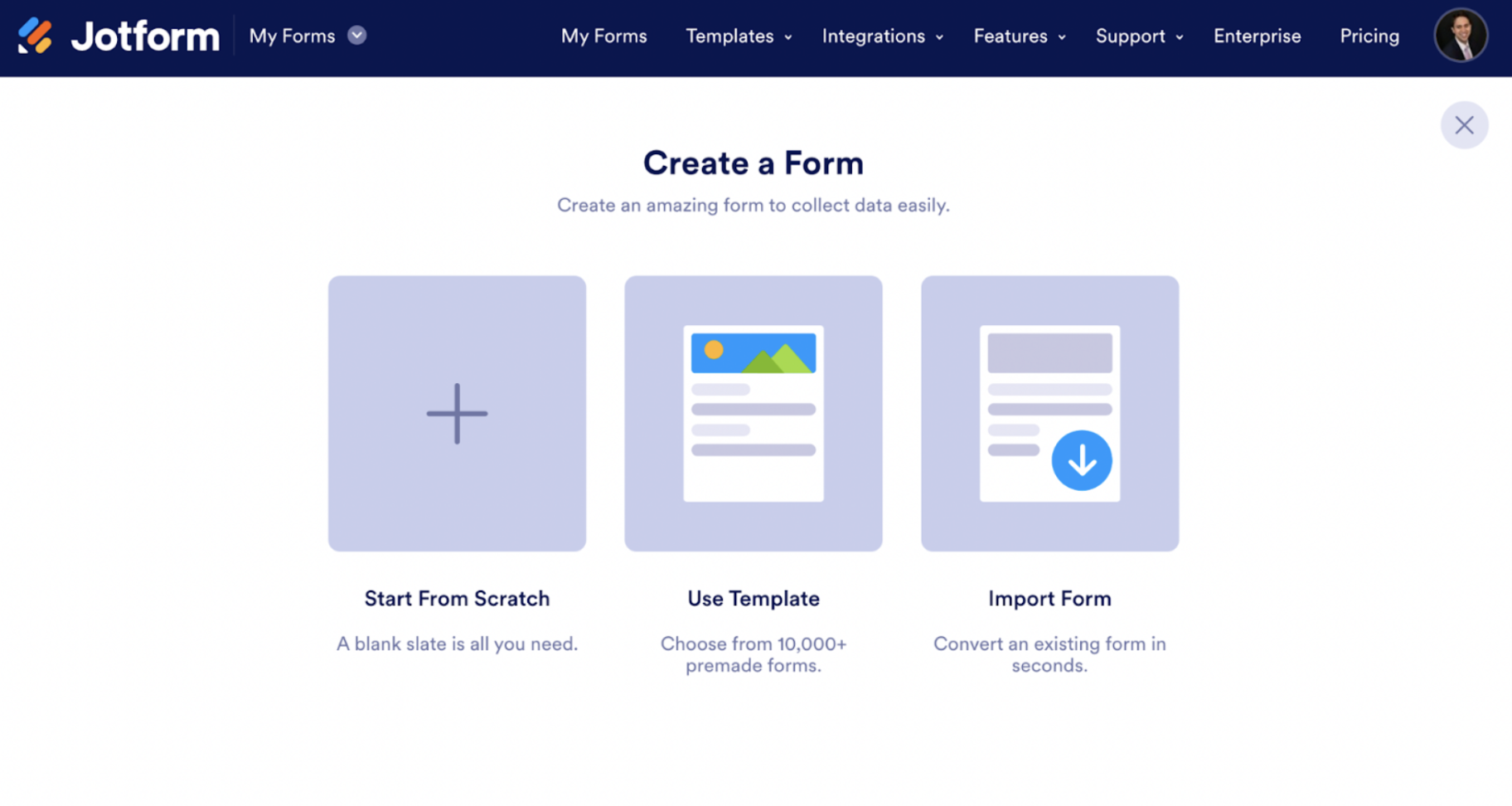
- Best for: Organizations that need to collect, view, and manage information
- Pros: Ease of use, extensive customization options, no coding experience needed, live collaboration, security and compliance features, integrations with 100-plus other software tools
- Cons: The extent of customization options can be overwhelming to new users
- Pricing: Free plan, Bronze ($34/month), Silver ($39/month), Gold ($99/month), Enterprise (custom pricing), discount for nonprofits and educational institutions
- Capterra rating: 4.7
Customer review: “Jotform makes our team much more efficient. We’re able to streamline processes that would normally take our team a lot of time to complete. For example, rather than posting a job application and combing through all the CV’s that show up in our inbox, we’re able to use Jotform to host the applications and easily view the submissions in one grid. We can also designate which team members should receive certain applications, so that everyone is notified in real time and there’s no need to go through and forward messages. It’s been so helpful to us, and I can’t recommend it enough for automating processes.” — Patty B.
Jotform is the online form builder for everyone. You don’t have to be a developer to use it because creating powerful forms is as easy as clicking and dragging. Select a template, add questions, publish, and watch the responses roll in.
However, it’s Jotform’s unmatched collaboration functionality that makes it the preferred online form tool. Simply share your links with coworkers and let team members work on the same form simultaneously.
Changes are saved in real time, so there’s no need to worry about whether you’re working on the most recent version. Additionally, Jotform’s revision history lets you view changes and revert to a previous version if needed.
Jotform empowers your team by
- Helping you build the forms you need in minutes
- Integrating your forms with over 150 different applications
- Collecting online payments with ease
2. Slack
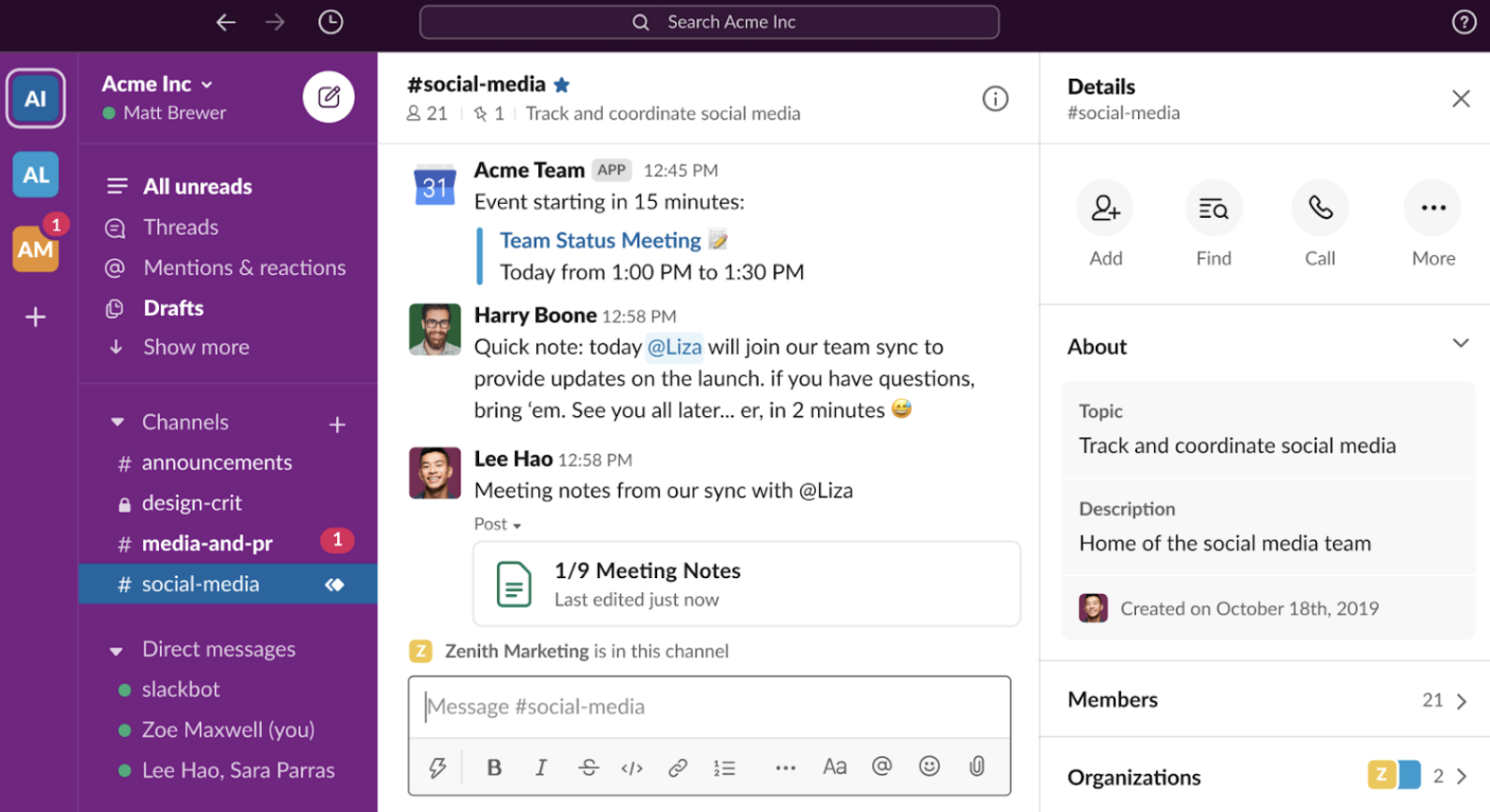
- Best for: Organizations that need to streamline team member communication
- Pros: Direct and group messaging, audio and video communication features, integration with other software, built-in collaboration tools, segmentation according to teams or projects
- Cons: Somewhat limited search function, potential to overwhelm users with frequent notifications
- Pricing: Free plan, Pro ($7.25/user/month), Business+ ($12.50/user/month), Enterprise Grid (custom)
- Capterra rating: 4.7
Customer review: “My experience with Slack has been fantastic. It’s an intuitive platform that makes team communication seamless and enjoyable…. It’s simple, organized, and keeps everyone connected. It’s the go-to tool for smooth and enjoyable teamwork. Honestly, I can’t think of much to dislike about Slack. If I had to nitpick, sometimes the notifications can be a bit too much, but it’s a small trade-off for staying in the loop. Overall, it’s a stellar platform for team communication.” — Francis D.
Described as a place “where work happens,” Slack is an instant messaging platform for work. It offers critical features like real-time messaging, file sharing, voice calls, a searchable archive, and screen sharing. These capabilities make it a perfect software solution for remote workers because it’s easy to collaborate with team members wherever you are.
Slack serves as a communication hub by
- Organizing communication channels by project, topic, or team
- Offering powerful search features so you can find information when you need it
- Securing the privacy of your conversations and files
Video conferencing
3. Zoom

- Best for: Organizations that need to have remote, synchronous meetings
- Pros: Multiple ways to invite meeting participants, ability to separate participants into smaller groups, in-meeting whiteboard function
- Cons: Potential for meeting disruption from updates; meeting length and participant limits with free plan
- Pricing: Free plan, Pro ($15.99/user/month), Business ($21.99/user/month), Business Plus ($26.99/user/month), Enterprise (custom)
- Capterra rating: 4.7
- Customer review: “Zoom makes it easy to set up calls, dial in and conduct a smooth call remotely. Working in a fully remote setting zoom has always ensured smooth operations. Breakout rooms, screen sharing and whiteboards are the most crucial features in my team.” — Sasha R.
Video conferencing is indispensable for a remote team. Team meetings, client meetings, and webinars are all possible with the right web client. Zoom is one of the most well-known video conferencing clients. Its easy-to-use interface, large meeting capability, and screen sharing are tools most people have depended on during the pandemic.
Zoom fosters team collaboration by
- Empowering your team with an always-ready meeting place
- Enhancing meetings with whiteboard, annotation, and file sharing features
- Giving users a familiar and easy-to-use interface
4. Krisp

- Best for: Remote workers in noisy environments
- Pros: Accuracy in detecting background noise, AI meeting assistant, echo reduction
- Cons: Device specification requirements, incompatible with some headphones and microphones
- Pricing: Free personal plan, Business ($12/user/month), Enterprise (custom)
- Capterra rating: 4.8
- Customer review: “I was amazed and shocked to see the impact of this after I came to know about Krisp and installing it. The software interface is quite easy to use and handles almost all of the tools in one place. The voice quality increases significantly and I need not worry about my normal surrounding noise anymore.” — Verified Capterra reviewer
Clarity is key to good communication. When you’re working remotely, your environment may not always be ideal for taking a call. Krisp uses AI-powered software to remove background noise from your call — ensuring clarity regardless of where you are.
Krisp improves meeting communication by
- Working with over 800 different apps
- Fully supporting different headsets, microphones, and speakers
- Providing advanced audio features like acoustic echo removal and HD voice
File storage
5. Google Drive
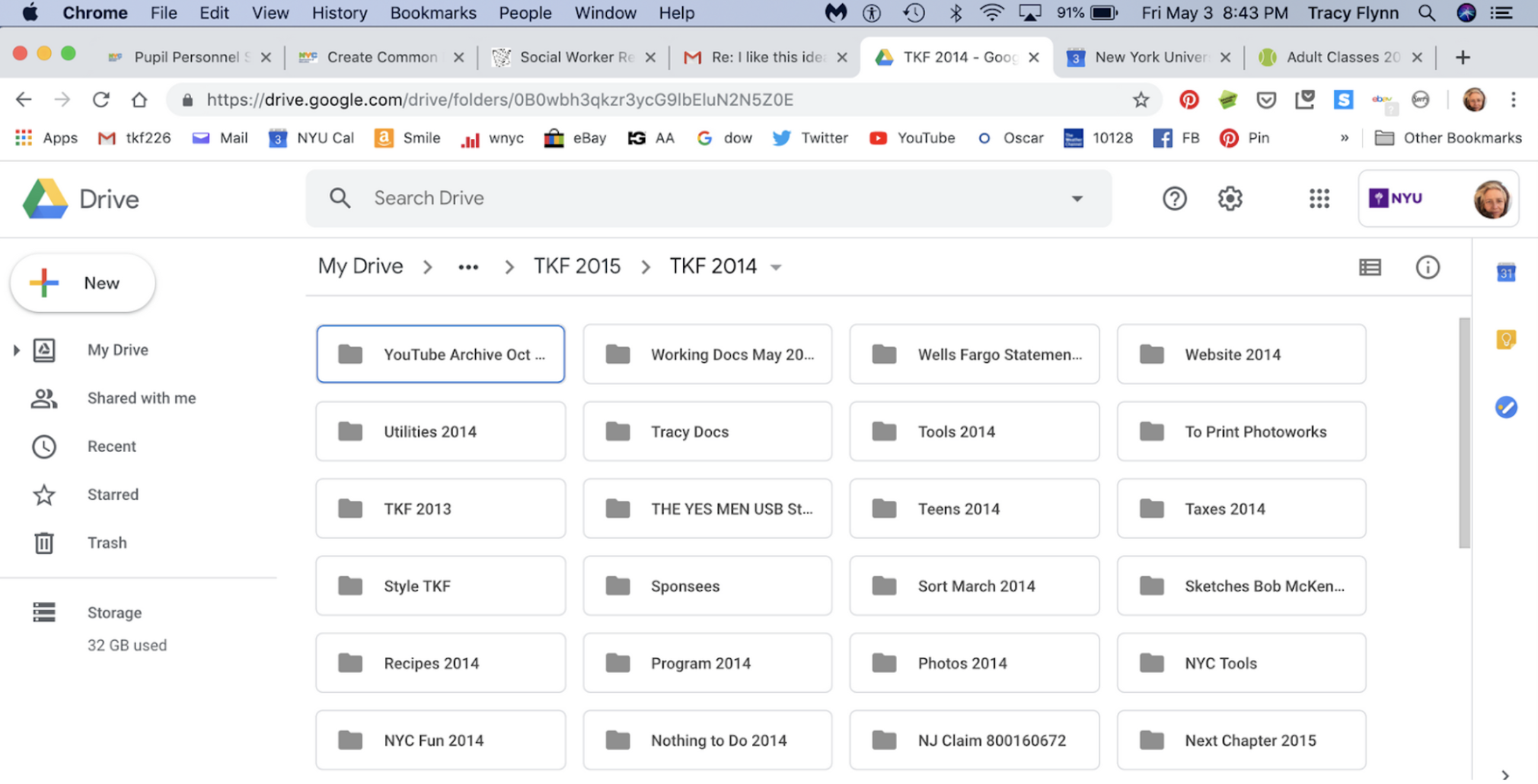
- Best for: Easily editing and organizing multiple documents
- Pros: 15 GB free storage, easy sharing options, live collaboration
- Cons: Limited offline capability, daily upload limit of 750 GB, inability to preview large files, no simultaneous upload/download functionality for large files
- Pricing: Free personal plan, Business Starter ($6/user/month), Business Standard ($12/user/month), Business Plus ($18/user/month), Enterprise (custom)
- Capterra rating: 4.8
Customer review: “Personally, I love it and wish more people and businesses used it. I love when I only need to use one product or vendor for multiple solutions. With my Google Drive subscription, I can manage my files, data, photos, videos, and more with a single login. For my business, it’s critical to function.” — Terence C.
Google Drive needs no introduction. You don’t want remote work to stifle your ability to store and share important documents. Google Drive gives you that and more. It lets you store and organize documents; collaborate with team members in real time regardless of geographic location; and share documents, spreadsheets, or presentations with whomever you choose.
Google Drive gives you file management superpowers by
- Allowing you to access your Google Drive account from anywhere
- Giving you powerful version control features
- Providing cloud-based file management to teams of all sizes
6. Dropbox

- Best for: Securely storing and sharing large files
- Pros: Multiple layers of protection (including encryption), ability to preview large files, syncing for file uploads up to 2 TB
- Cons: Can be more expensive than comparable cloud storage services
- Pricing (for storage plans only): Free basic plan, Professional ($19.99/month for one user), Standard ($18/user/month), Advanced ($30/user/month), Enterprise (custom)
- Capterra rating: 4.6
- Customer review: “I use Dropbox every day for multiple aspects of my business. File Sharing is fast and easy. Backing up data – excellent. For remote work with clients keeping everything on Dropbox means we all have immediate access to the most up to date documents, spreadsheets, and marketing materials.” — Laura D.
Dropbox makes sharing large files easy, no matter where your team is located. With its powerful synchronization capabilities and the ability to share documents both within and outside of your organization, you can work more efficiently knowing you can access the files you need without having to wait.
Dropbox boosts your teams’ collaboration by
- Letting you preview documents without needing to download them
- Offering security features like password protection, multifactor authentication, and access expiration dates
- Allowing simultaneous upload and download of large files
Productivity
7. Tettra
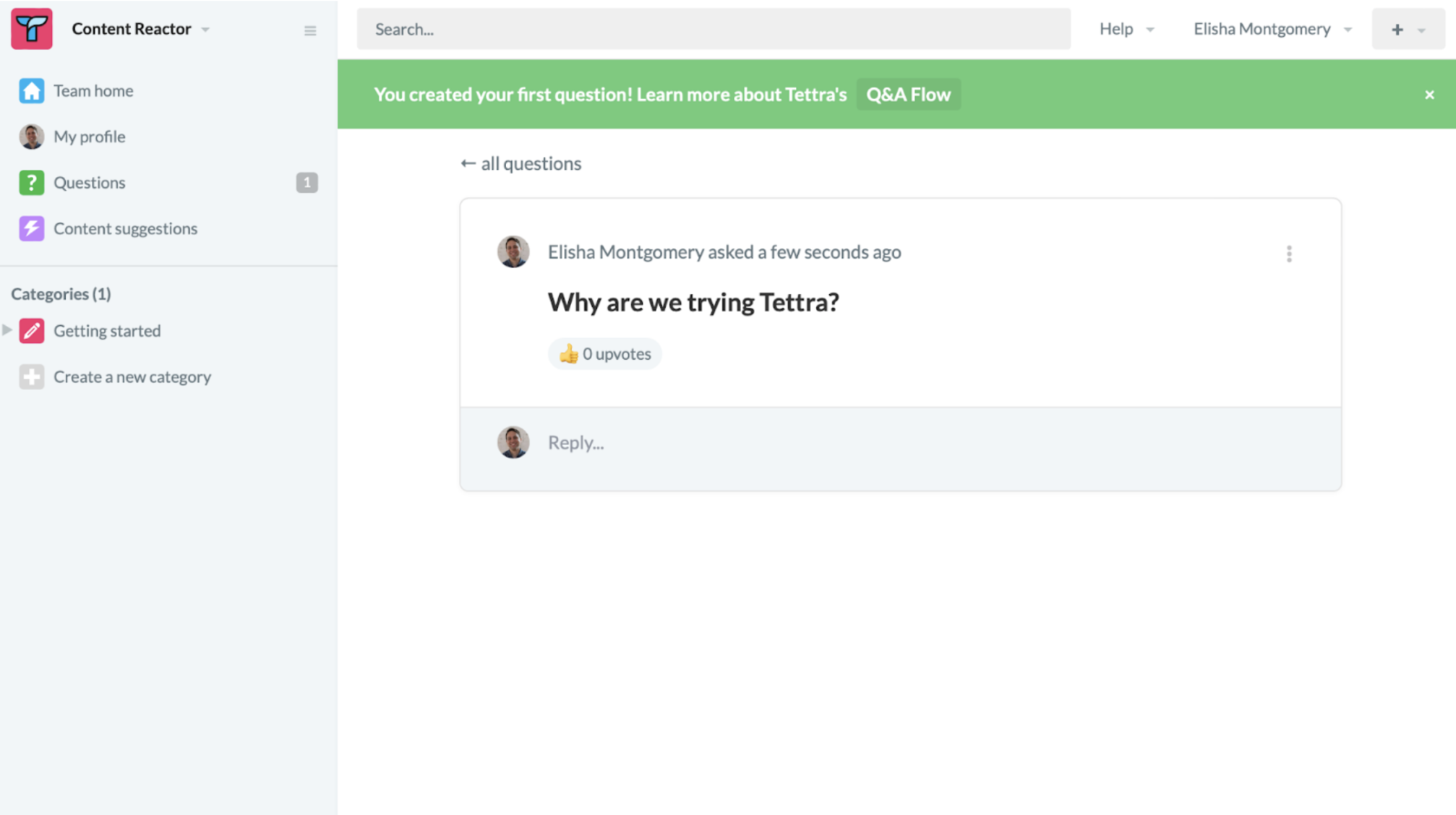
- Best for: Teams that want a centralized location for their organizational knowledge base
- Pros: AI assistant, integration with other software, ability to share internal pages externally with clients and vendors
- Cons: No simultaneous collaboration on drafts, limited customization options
- Pricing: Basic ($4/user/month), Scaling ($8/user/month), Professional ($7,200/year for up to 50 users)
- Capterra rating: 4.1
- Customer review: “Tettra’s interface with Slack is quite beneficial because we can search up information, create new pages, and quote other Wiki sites to contextualize remarks in a Slack thread…. Since only one person can work on a draft at a time, Tettra should create a collaborative draft (like Google Docs) would be fantastic. I haven’t had any other issues or problems.” — Hèlia T.
Sharing knowledge is critical to ensuring your team can work effectively. However, this process is often clunky and challenging when you have a remote team.
Tettra is a company wiki application that helps build your internal knowledge base. It allows your company’s experts to share knowledge and answer questions on their own time while making that knowledge available to everyone.;
Tettra makes sharing expert knowledge easier by
- Giving you one place to store FAQs, subject matter expertise, etc.
- Allowing experts to answer questions asynchronously
- Integrating with Slack to let your team respond to questions at the source
8. Miro
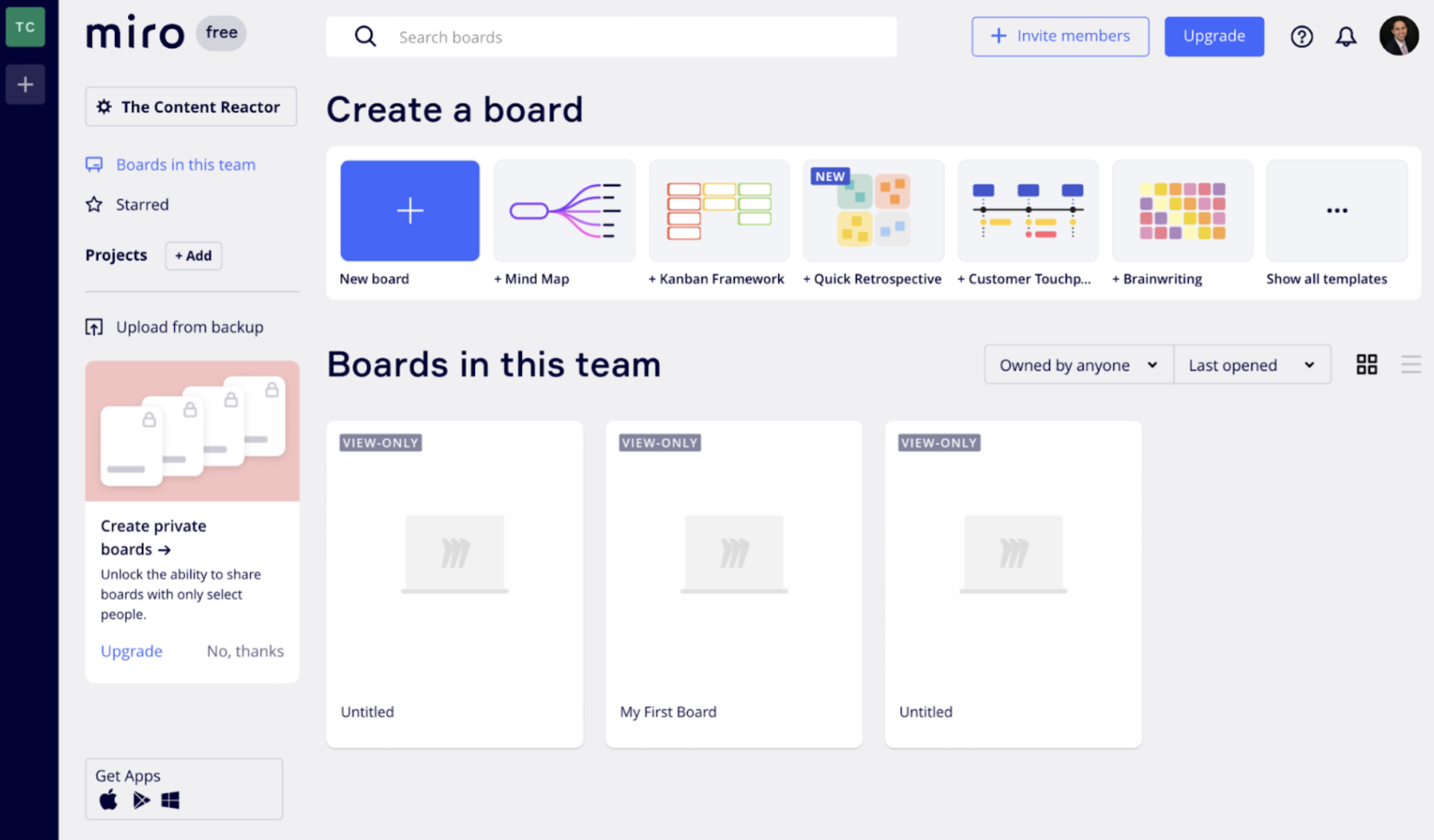
- Best for: Teams that need to collaborate by visually expressing ideas
- Pros: Live collaboration, premade templates, endless canvas
- Cons: Potentially steep learning curve, limited exporting options
- Pricing: Free plan, Starter ($8/user/month), Business ($16/user/month), Enterprise (custom)
- Capterra rating: 4.7
- Customer review: “I have had nothing but good things to say about Miro…. I think Miro’s endless canvas is its strongest suit because it allows users to quickly and easily turn their thoughts into eye-catching visuals. The canvas is an enormous creative playground that may accommodate endless brainstorming sessions, mind mapping, and team projects.” — Stephanie J.
The whiteboard is one of the most essential remote work tools for collaborative ideation. Miro is a digital whiteboard application that takes the traditional whiteboard experience to the next level. It allows users to work asynchronously and build on an infinitely expandable canvas. Use Miro for planning, ideation sessions, and meetings.
Miro makes brainstorming more engaging by
- Enabling videoconferencing side by side with your whiteboard
- Providing ready-to-go templates for user story maps, fishbone diagrams, mind maps, and more
- Integrating with the tools you already use
9. Zapier

- Best for: Small and mid-sized businesses that want to automate processes without having to code
- Pros: No need for coding experience, AI features, premade templates, ability to schedule automations
- Cons: Some vague or confusing notifications about failed automations, trial and error when setting up complex automations, no live customer support
- Pricing: Zapier offers five tiers (Free, Starter, and Professional for individuals; Team and Company for groups). Pricing depends on the number of automated tasks an organization needs in a month.
- Capterra rating: 4.7
- Customer review: “If two platforms do not connect, Zapier has covered you. With the ease of a few clicks, you will get them working together without needing a programmer. That can save you time and money, which is helpful for marketing or other departments that need to integrate two products. The documentation of Zapier is fantastic and helps you to set up things in the right way.” — Lukas M.
No single digital tool can solve 100 percent of your organization’s needs, and that’s where Zapier comes to the rescue. By creating workflows known as “Zaps,” Zapier automates processes between services, freeing you and your employees up to focus less on everyday maintenance tasks and more on the work that matters most.
Zapier optimizes your organization’s time by
- Letting you connect more than 6,000 commonly used apps
- Offering a drag-and-drop visual builder instead of requiring coding to create automations
- Eliminating the need for manual data entry
Task management
10. Trello

- Best for: Organizations that need to plan and manage projects collaboratively
- Pros: Ease of use, real-time updates, premade templates, integration with other software, multiple ways to view projects
- Cons: Images are uploaded as attachments instead of displaying in cards, no advanced project management tools like time tracking, limited customization optoins, limited offline capability
- Pricing: Free plan, Standard ($5/user/month), Premium ($10/user/month), Enterprise ($7.38–$17.50/month, depending on number of users)
- Capterra rating: 4.6
- Customer review: “Honestly, there are so many things to like about Trello, how user-friendly it is, you can literally teach anyone how to use Trello in less than 20 minutes. Super easy for people who are starting doing project management, visually a blast and you are able to have full visibility of stages and day-to-day tasks. Managing backlog is super easy and you are able to truly focus on what is important and not feel like you [are] leaving anything out.” — Astrid A.
Managing a team is no easy feat. Managing a remote team can be even trickier, especially without the right remote work tools.
Trello is a simple web-based tool that’s useful for individual task management or project management for an entire team. It lets you assign tasks to individual team members or groups, track the progress of the tasks, and remind people of important deadlines.
Trello’s mobile app is simple to use, making it perfect for the remote worker on the go.
Trello makes project management easier by
- Organizing tasks and projects into powerful task cards and boards
- Allowing you to add checklists, due dates, attachments, and more to every card
- Empowering you with built-in automation to offload tedious tasks
11. Toggl Track

- Best for: Workers who manage multiple clients, projects, or tasks simultaneously
- Pros: Integrations with Google Calendar and other software, tracked time display in multiple formats, organization features like tags and colors
- Cons: Inability to edit time tracked with stopwatch feature, inability to add collaborators to specific spreadsheets only
- Pricing: Free plan, Starter ($10/user/month), Premium ($20/user/month), Enterprise (custom)
- Capterra rating: 4.7
- Customer review: “As someone whom clients frequently hire for projects and/or consulting work, I love how easy Toggl Track makes it to track how much time I spend on each project/client. Accurate invoicing and timekeeping is a breeze.” — Firenze M.
Time tracking can help you measure team productivity and forecast employee needs. Toggl Track is tracking and reporting software designed to help teams manage billable hours, improve productivity, and share valuable insights. Toggl Track’s platform is super easy to use, and employees can start tracking time even before giving tasks a name.
Toggl Track improves time tracking and management by
- Providing a simple interface that’s accessible on any device
- Offering reports that provide a micro or macro view of performance
- Improving invoicing accuracy and ensuring you’re being paid what you deserve
12. Asana

- Best for: Teams that collaborate on major projects
- Pros: User-friendly tool, automation features, customization options, multiple ways to visualize deadlines
- Cons: Storage and collaboration limits, limited reporting and analytics
- Pricing: Free personal plan, Starter ($10.99/user/month), Advanced ($24.99/user/month), Enterprise (custom pricing)
- Capterra rating: 4.5
- Customer review: “Asana has allowed our office to both keep extremely flexible and extremely specific project to-do lists. It also allows us to keep our conversations about an issue or project in one place, archived for all time. Additionally, we are able to keep reference information about each project in Asana, creating one central place to check for details, status, and tasks on each project.” — Odette S.
Project and task management are essential to completing projects and delivering them on time. Asana unifies your team’s work in a shared space. In Asana, your team can communicate, track progress, view project milestones, and share files. It ensures that all relevant project files stay in a single organized location.
Asana facilitates project and task management by
- Allowing you to customize project views based on your team’s working style
- Automating routine tasks with rules
- Offering over 200 integrations to connect all of your software
Employee experience
13. Assembly

- Best for: Teams that want to increase employee morale and engagement
- Pros: Personalization capabilities, multiple ways to redeem points, data and analytics features, integrations with other software
- Cons: No mobile version, minimum character limit to send praise to colleagues, limit on how many points colleagues can send each other
- Pricing: Recognition ($2/user/month), Engagement ($4/user/month), Digital HQ ($6/user/month), custom plan
- Capterra rating: 4.8
- Customer review: “The platform is extremely user-friendly and I love how you can tag different badges to each recognition that you send out! Also love the options of retailers that you can redeem your rewarded carrots. It’s like an employee-to-employee bonus structure, without having an actual bonus structure!” — Allie A.
Recognition is key to motivating employees to do their best work. However, celebrating your best people is harder on a remote team.
Assembly is a workflow automation tool with employee recognition and team connection at its core. It enables you to celebrate employee accomplishments, nominate top performers, and offer motivating rewards.
Assembly promotes remote team productivity by
- Enabling you to add structure to your day with daily and weekly agendas
- Helping you celebrate employee achievements with public shout-outs
- Letting you offer rewards easily from more than 600 different possibilities
14. WorkTango

- Best for: Showing recognition and appreciation to employees
- Pros: Integrates with other software, offers diverse rewards
- Cons: No automatic issuing of rewards, potentially confusing point redemption procedure, company-wide visibility of employee activity
- Pricing: Surveys & Insights (minimum annual contract of $8,000/year), Recognition & Rewards (minimum annual contract of $8,000/year), Full Employee Experience Platform (minimum annual contract of $10,000/year)
- Capterra rating: 4.9
- Customer review: “I think it has been a great tool for our company to keep people motivated and inspired to do good. I love the ease and ability to integrate with Slack…It also is fun to see what people get recognized for, whether it be bringing in a snack or cleaning up the kitchen or even helping each other out on a project.” — Missy F.
A remote workforce still needs connection and engagement from leadership. WorkTango enables employees to stay connected with the organization and helps management keep people motivated. It offers tools that help teams set goals and OKRs, celebrate wins, have meaningful conversations, share feedback, and reward culture-building behavior.
WorkTango brings teams together by
- Creating goals at the individual, team, department, and company level
- Setting up one-on-one and performance review conversations
- Making it easy for employees to provide feedback to one another
Equipment management
15. Firstbase

- Best for: Remote workers who need physical equipment
- Pros: Makes onboarding easier on managers, adds new features frequently, provides dedicated support team
- Cons: Difficulty with filtering items, no pricing transparency
- Pricing: Contact sales
- Capterra rating: 4.5
- Customer review: “User onboarding – my team was able to select devices and peripherals before they started, and it all arrived on time. Support issues – when the screen broke on a team member’s laptop, they managed a loaner laptop When employees leave, they sent a custom box, labels, emails to make it easy for packing and dropping off I had a minor support issue but a manager called me personally to understand the problem and we worked it out.” — Paul F.
Remote employees may not go to an office, but they still need good equipment to do their jobs. Firstbase helps companies distribute and manage their team’s equipment, including computers, printers, and furniture. Firstbase makes it easy to keep track of equipment and provides simple billing.
Firstbase streamlines employee equipment management by
- Automating the equipment selection process during onboarding
- Simplifying equipment billing under a single vendor
- Helping with the retrieval and redistribution process during offboarding
Human resources
16. Gusto

- Best for: Startups and small businesses
- Pros: Integration with other apps, additional features for independent contractors, compliance assistance, time-tracking feature, mobile app for employees
- Cons: Long wait times for customer support, manual data entry required, no mobile app for employers
- Pricing: Simple ($40/month, plus $6/user/month), Plus ($80/month, plus $12/user/month), Premium (Contact sales), Contractor-only ($35/month, plus $6/contractor/month)
- Capterra rating: 4.7
- Customer review: “This system is not only easy to set up but the user end is incredibly friendly. The system tracks all of our payroll, PTO and tax information and all but runs itself. After having used a few other options this was by far the best value for our money..” — Rachel D.
Payroll and onboarding are a critical part of your business operations. Gusto is a payroll, benefits, and HR platform built for modern businesses. It allows companies to quickly onboard employees, speeding up important tasks like sending offer letters, filling out onboarding paperwork, and managing IT devices.
Gusto simplifies payroll and HR by
- Calculating and filing payroll taxes automatically
- Providing access to certified HR professionals
- Housing all of your payroll, onboarding, and HR documents in one place
Supercharge your remote team with powerful applications
Remote work is the new normal, and companies need to adapt. The software applications we’ve considered can help you improve collaboration and communication across your organization. Use technology to lead the way among remote organizations.
If you work remotely or with a distributed team, what are your essential remote work tools to ensure productivity? Let us know in the comments!




























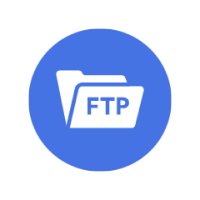











































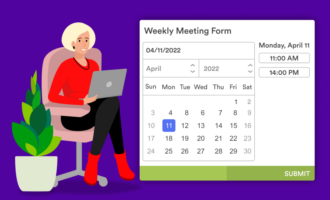

























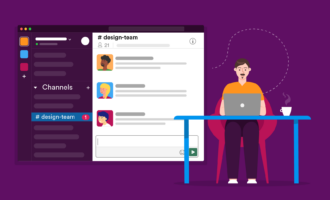








Send Comment:
7 Comments:
More than a year ago
I agree that using digital tools helps increase productivity, and I use TMetric every day to help me manage my time and be more effective at work. The program enables for easy job planning and displays productivity bars directly on the timeline. Additionally supported and ideal for personal use is the free plan.
More than a year ago
In my case, I switched to Kanban Tool () after using some other tools but I feel this works the best for me. It lets me completely focus on my work. I can easily personalise each proyect and funcionalities just makes all goes faster :)
More than a year ago
For me, the main tools for working remotely are Google Drive, Google Calendar and Checkiant time tracker. Simple and at the same time very useful tools. I think everyone who works remotely has their own list of tools that they can't work without.
More than a year ago
Decent remote work is impossible without proper privacy for corporate data. Services with public servers (Slack, Zoom) has cases with data breach and that is unaccaptable for any company. You should add some software that has own, non-public server (e.g. MyChat corporate messenger, etc.), and allows you to work without internet, but via internal local network (LAN, Wi-Fi).
More than a year ago
Great post you’ve posted here on remote working developers.
Keep Sharing.
More than a year ago
Noticed that you didn't include kickidler in your article. I think you should consider using employee monitoring software. This program allows you to monitor the computers of remote employees. In addition to the option of creating a recording, you can also keep track of your employees' productivity. It will improve over time since the employees will sense your supervision and approach work in a more responsible way.
More than a year ago
The above tools are good but you forgot to add on premise R-HUB web video conferencing servers in the above list. It works on all platforms plus provides 6 realtime collaboration applications in one box.